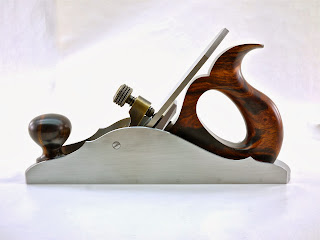This tool is bedded at a low angle of 38 degrees. It's a bevel down design so 38 degrees is the effective cutting angle. This configuration puts the bevel of the iron almost in a line with the cutting action of the plane. With a primary grind of 25 degrees and then a secondary bevel of 27 to 28 degrees it still has around 10 degrees of clearance angle. Plenty, but it does need to be maintained.
The threaded holes serving as assembly points will have taper pins interspersed between those locations when all the parts are in place. This creates a very accurate and rigid structure, for all practical purposes a metal torsion box. The taper pins go into reamed holes and fit zero clearance. When the pins are set with a hammer it creates what we used to call in the fabrication industry, "End of the World Stuff".
If I've performed my work correctly it goes together marvelously well and makes a well fitted assembly. For this to happen quite close tolerances have to be maintained on every part that makes up the assembly.
All the grinding of the interior surfaces has to be completed prior to assembly and then protected during subsequent operations. Clean vises and not trapping chips between vise cauls and the interior of the plane body is something that requires close attention. Other wise it is possible to damage areas that are no longer accessible for further work. When the threaded assembly pins are in place, peined and the taper pins are installed, it's then time to refine the exterior surfaces. Of course one of the most important functional surfaces on any plane is the sole.
The components of this plane are made from so-called precision ground stock. It is supposedly flat to .001 over a distance of 12 inches. I find that it is rarely this accurate. What comes in as precision ground and what leaves my shop as precision ground are two entirely different versions.
While grinding a designated amount of material is removed per pass. This differs depending on the material being work. Most are surprised to know that harden material like plane irons are actually easier to grind than the annealed material that makes up the body of the plane.
As you proceed with this work the material warms slightly and expands. In a process that starts with material being removed by 5 tenths to 6 tenths of one thousandth per pass, the final passes will be in the 2 to 3 tenths range. The entire body of the plane is allowed to completely cool again to the ambient temperature of the shop prior to making the final passe. On the first of the two final passes material will almost always be removed at the toe and the heel and not in the center of the sole which has cooled and contracted. Only after these final passes do you achieve a sole that is in fact quite extremely flat. Not allowing the plane body to cool prior to the last passes will leave a slightly low area just before and aft of the mouth opening.
Ron
Leon Redbone was performing in Savannah, Ga. and was accompanied by a gentleman playing the tuba. During a break between songs the tuba player turns to Leon and says "Leon the Invisible man is here", Leon replied, "tell him I can't see him right now!"

















